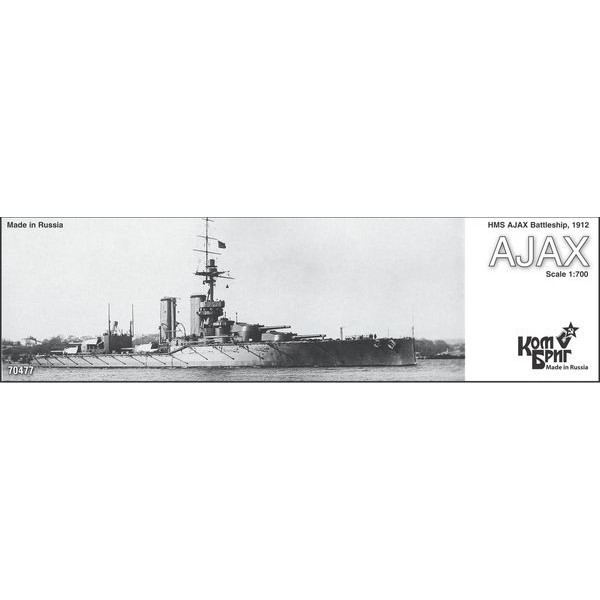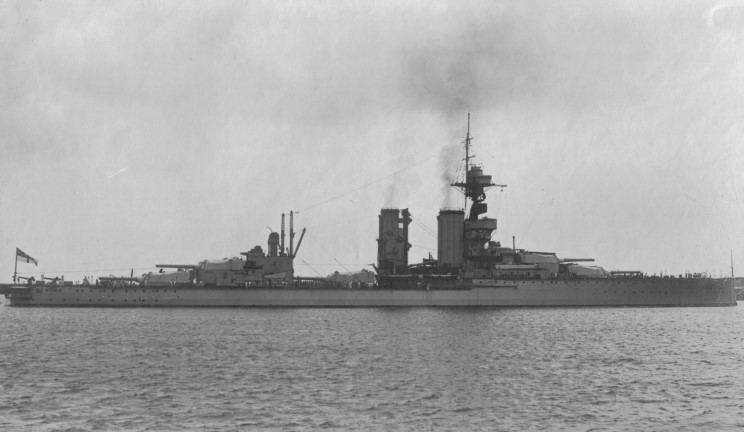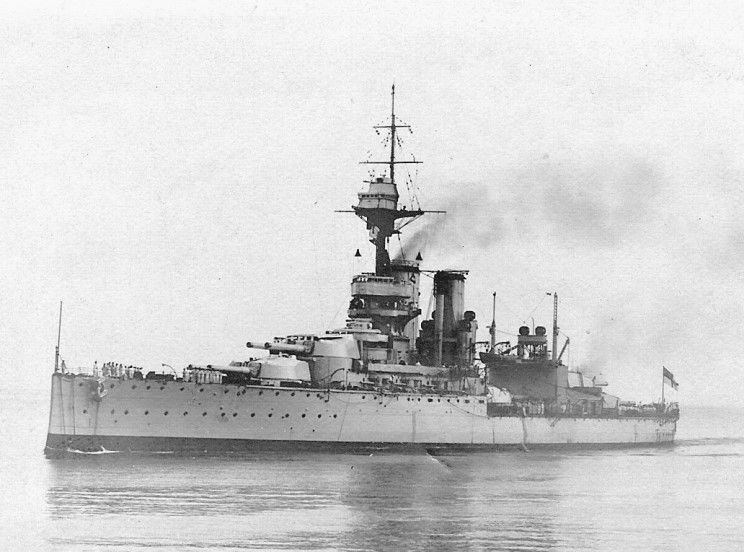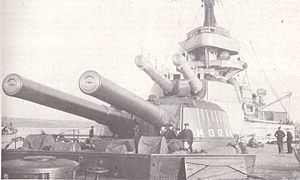Name Ajax Laid down 27 February 1911 Decommissioned 1924 Launched 21 March 1912 Draft 8.38 m | Ordered 1910 Commissioned 31 October 1913 Construction started 27 February 1911 Length 182 m | |
 | ||
Fate Sold for scrap 9 November 1926 | ||
HMS Ajax was a King George V-class battleship (one of four ships of the class), built at Scotts' shipyard at Greenock on the River Clyde. She was completed in 1913 and saw action at the Battle of Jutland in 1916 and in the Mediterranean and Black Seas in 1919, before being decommissioned in 1924.
Contents

The armed merchant cruiser HMS Princess served as a dummy for Ajax beginning in 1916.
Design and description

HMS Ajax was the last of the four ships of the King George V-class battleships to be laid down. The class had been intended to be a repeat of the preceding Orion class, but experience with this class enabled improvements to be incorporated into Ajax, and her sister HMS Audacious, at an early stage of construction. The most significant of these, and that which added most to her fighting efficiency, was the positioning of the foremast forward of the fore-funnel rather than behind it. It had been found that in ships in which the foremast and the fighting top were aft of the funnel, which arrangement existed in HMS Dreadnought herself and in the Colossus class, funnel smoke could render the fighting top essentially uninhabitable. This ship, together with HMS Audacious, was also designed, unlike her earlier sisters HMS King George V and HMS Centurion to be equipped with director firing which necessitated the provision of a stronger foremast than had been initially envisaged. The internal armour protection was also improved as against the earlier class, the anti-torpedo armament was improved (q.v.) and the speed increased by about one knot.
Building data

Ordered under the 1910 construction programme, Ajax was built by Scotts' Shipbuilding and Engineering limited at their Greenock yard on the River Clyde, she was laid down on 27 February 1911 and launched on 21 March 1912. She commissioned in to the 2nd. Battle Squadron of the Home Fleet on 31 October 1913.
Armament

The main armament consisted of ten 13.5 inch (343mm) 45 calibre Mark V guns, disposed in five twin turrets all on the centre-line of the ship. The turrets were identified with letters, as was the general naval custom. "A" turret was situated on the forecastle; "B" was immediately aft, one deck higher and in theory superfiring over "A". "Q" turret was placed amidships, at maindeck level, between the after funnel and the aft superstructure. "X" was placed on the quarterdeck immediately aft of the after superstructure, at the same level as "A" turret; "Y" was immediately aft of "X" and at maindeck level, allowing superfiring of "X" over "Y". In practice, because of the practice of positioning of sighting hoods on the turret crowns, firing of the superfiring guns directly over the lower turrets was found to seriously adversely affect the crew of the lower turret.

The maximum elevation of the guns was 20 degrees, which was an increase over previous dreadnought classes. The arcs of fire of "A", "B", "X" and "Y" were all stated as 300 degrees, although it was recognised that firing too close to the superstructure would cause significant damage to it. "Q" turret was also stated to have an arc of fire of 300 degrees, on the basis that at full elevation its shells would pass over the after superstructure. At anything less than full elevation the arc of fire was about 115 degrees on either beam; again, with the risk of causing blast damage if firing too near either the fore or after superstructure.

The guns fired a shell weighing 1,400 pounds, and the maximum rate of fire was two rounds per gun per minute, although to allow for the spotting of the fall of shot one round per minute was more usual.
Secondary armament
Ajax's secondary armament was sixteen 4-inch (102mm) Mark VII breech-loading guns, arranged in single mounts. In response to the perception that a threat from torpedo-boats was most likely to originate forward of the beam, twelve of these guns could bear forwards and four aft. On completion the forward guns were disposed on three levels; on either side one below the conning tower at the level of "Y" turret, three in the superstructure at forecastle deck level, and two in the forecastle hull level with "B" barbette. The after guns were disposed above each other immediately forward of "X" turret. All of these guns had three inch armour protection. The guns in the forecastle were found to be unserviceable in any sort of sea, and were removed, and the casemates plated over, during the First World War.
At the time of the design of these ships the dreadnoughts of other major navies were being equipped with secondary armament of calibre of 5 inches (U.S.A.), 5.5 inches (France) and 6 inches (Germany, Japan, Austria). Ajax and her sisters received the smaller calibre for two reasons; the Government, who held to a policy of reduction of expenditure on armaments, were not prepared to allow the extra expenditure of an estimated £170,000 which would have been entailed; and Admiral Fisher, the First Sea Lord, who had been largely responsible for the basic conceptual design of the armament of British dreadnoughts was firmly opposed to a heavier secondary armament.
In 1915 two 4-inch anti-aircraft guns were installed on the quarterdeck.
Also carried was one 12-pounder gun, four 3-pounder saluting guns, and five Maxim machine guns and ten Lewis guns.
In common with other dreadnoughts of the period, Ajax carried three torpedo tubes. One bore astern and there was one on either beam all firing 21 inch (533mm) Whitehead torpedoes.
Armour
The main armour belt was of twelve inches (305 mm) thickness, and ran from abreast of "A" barbette to abreast of "Y" barbette. The upper belt ran the same length along the ship, and was nine inches (229 mm) amidships, tapering at either end to eight inches (203 mm) . At normal loading the belt extended 16 feet 10.5 inches (5.144 m) above the waterline and 3 feet 7.5 inches (1.105 m) below it
The citadel, the central vital part of the ship on which depend both buoyancy and fighting ability, was closed forward by a bulkhead ten inches (254 mm) thick, running from the ends of the belt and merging with the forward armour of the barbette. Similarly, a ten-inch (254 mm) bulkhead closed the citadel after end. Both bulkheads tapered in thickness below the armoured deck; the forward one to six inches (152 mm), the after one to four inches (102 mm).
The turret faces were eleven inches (279 mm) thick; the sides, which were not expected to be turned to an opponent, were four inches (102 mm); the roofs were three inches (76 mm).
There were three armoured decks. The main deck was given 1.5 inches (38 mm) of armour; the middle deck 1-inch (25 mm); and the lower deck, which was designed as the main defence against plunging fire and lay immediately over the magazines, shell rooms and machinery spaces, was from one to two inches thick forward and from three to four inches (102 mm) thick aft.
The barbettes were covered with armour from three to ten inches (254 mm) thick, the amount depending on the degree of protection expected to be afforded by adjacent structures.
The conning tower received eleven inches (279 mm) of armour, and the after director tower six inches (152 mm).
Machinery
Four Parsons turbines drove four shafts. The drive was direct, with no reduction gearing. Steam was supplied by eighteen Babcock & Wilcox boilers, disposed in three boiler rooms with six boilers in each. The designed shaft horsepower (SHP) was 27,000 and the design maximum speed was 21 knots (39 km/h). Maximum fuel load was 3,100 tons of coal and 840 tons of oil, giving a radius of action at 10 knots (19 km/h) of 6,310 nautical miles (11,690 km). Power could be increased to 31,000 shp (23,000 kW) for short periods; the maximum four-hour speed for Ajax was 21.7 knots (40.2 km/h). The radius of action at 18.15 knots (33.61 km/h) was found to be 4,060 nautical miles (7,520 km).
Career
Ajax was laid down at Scotts yard on 27 February 1911. She was launched on 21 March 1912 and completed in March 1913. She underwent sea trials during April 1913, and was commissioned into the first division of the second battle squadron of the Grand Fleet at Devonport on 31 October 1913. Her only distinctive pre-war activity was her participation, with her sisters HMS King George V, HMS Audacious and HMS Centurion, at the Kiel canal celebrations in June 1914. She transferred to Scapa Flow with the rest of the Grand fleet on 29 July 1914, in response to the increasing political tension in Europe.
She remained with the Grand Fleet for the duration of World War I. She saw action only at the Battle of Jutland on 31 May 1916. In this action the first division of the second battle squadron, commanded by Vice-Admiral Sir Martyn Jerram, consisted of HMS King George V, HMS Ajax, HMS Centurion and HMS Erin. The fourth sister ship, HMS Audacious, had been sunk by a mine on 27 October 1914. She sighted the leading ships of the battle line of the German High Seas Fleet and the German battlecruisers and fired on them. She herself received no hits; because of the number of ships involved it was not possible to establish if she made any hits on her targets.
She remained at Scapa Flow until June 1919, being transferred to the third battle squadron for the final four months of her time there. In June 1919 she was transferred to the fourth battle squadron, which formed part of the Mediterranean Fleet. She took part with her battle squadron in actions against the Bolsheviks and Turkish nationalists in 1919 in the Black Sea and in the Sea of Marmora. When the Sultan of Turkey was deposed in 1923 he was conveyed to Mecca in HMS Ajax.
In April 1924 she returned to Devonport, and was part of the Reserve Fleet until October 1926, when she was paid off onto the disposal list. On 10 December 1926 she was sold to Alloa Shipbreaking Company, and broken up at Rosyth from 14 December 1926.
